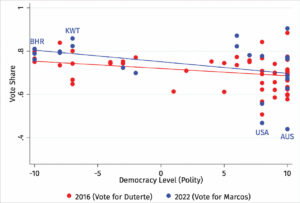Distance makes the vote grow farther: The Filipino migrant vote

The recently concluded Philippine elections saw the landslide win of Ferdinand Marcos, Jr., whose victory is historical for two reasons. First, while parts of the world have voted to reject candidates linked to former dictators and far right parties (e.g., Chile 2021, Peru 2021, France 2022), the Filipino people have thrown their support behind the son and namesake of the country’s former dictator. Second, this is the first election in more than 30 years that the winning presidential candidate has garnered a majority of the votes. This victory is also thanks to the millions of Filipino migrants worldwide.
THE FILIPINO MIGRANTIn 2019, the Philippines was the ninth highest migrant-sending country and the fourth highest remittance-sending country in the world. According to the Philippine Statistics Authority (PSA), as of 2020, there were 1.77 million overseas Filipino workers, most of whom reside in the Middle East (57.5%) and East Asia (17.7%), with Saudi Arabia and Hong Kong as the top two destinations.1 Filipino migrants are mostly engaged in low-skilled work: 46.7% in elementary occupations, 14.4% in service and sales, and 11.5% in plant and machine operations.2
These overseas Filipino workers comprise a large proportion of the Filipino voters abroad, which also include migrants who permanently reside in their host countries and are already dual citizens. Extraterritorial voting was first implemented in the 2004 elections and has since seen ever-larger figures for voter registration and turnout. While the numbers have grown tremendously, the COVID-19 pandemic caused migrants to go home in droves, leading to a reduction in the number of registered overseas voters for the 2022 elections at 1.7 million, down from 1.82 million in 2019. Data from the Commission on Elections shows that more than 40% of registered overseas voters come from the Middle East, and around 23% reside in East and Southeast Asia.
2022 PHILIPPINE ELECTIONS: A HISTORICAL JUNCTUREThe 2022 elections in the Philippines looked like a case of history repeating itself: the two main presidential contenders were the former dictator’s son Ferdinand Marcos, Jr. and the incumbent vice-president Leni Robredo, both of whom ran for vice-president in 2016. Interestingly, their contrast, as reported by the media, cannot be more stark: Marcos Jr. and his family have unpaid estate taxes of $3.9 billion, and he has lied about his educational background, while Robredo has no corruption cases to her name (a rare occurrence in top government posts), and her programs have been awarded for their best practices and efficiency. Despite this, history did not repeat itself: this time, Marcos Jr. won convincingly.3
HOW DID THE FILIPINO MIGRANTS VOTE?According to the latest available data, around 620,000 overseas voters cast their votes, resulting in a 36.5% turnout rate, which is significantly higher than the two previous presidential elections.4 While domestic voters gave Marcos Jr. 58.6% of the vote, overseas voters gave him a much greater majority — an unprecedented 72.7% of the vote. Of the countries and voting centers with available data, Marcos Jr. won all but one of those, with the main opposition candidate Robredo winning only one (Vatican City).
How does this compare with migrants’ historical voting behavior? Looking at the data, Filipino migrant voting behavior seems to be fairly consistent across space and time. In the 2016 elections, then presidential candidate Rodrigo Duterte received 38.7% of the domestic vote and 72% of the diaspora vote. Duterte went on to win 58 of 59 countries, with the second placer Mar Roxas getting only one (Vatican City). In the 2010 and 2004 elections, the winning candidates also received higher vote shares from the diaspora than the domestic voters: Benigno Aquino got 42% domestically and 55.7% overseas, while Gloria Macapagal-Arroyo got 40% and 44.4% respectively.
While the magnitudes vary, the trend of the diaspora providing stronger support towards the winning candidate is consistent. If any, the difference lies in the type of candidate that migrants support: sometimes they vote to maintain the status quo (in the case of Macapagal-Arroyo, who was the incumbent, and now Marcos Jr., who was seen as the “continuity” candidate to Duterte’s populism), and sometimes they vote for change (in the case of Aquino, who ran under a platform of eliminating corruption, of which Macapagal-Arroyo was accused; and in turn with authoritarian-leaning Duterte, who was the opposition candidate to Aquino’s liberal governance).
WHAT EXPLAIN THE DIASPORA VOTE?At an aggregate level, it seems that migrants tend to vote in high proportions for the same candidate. However, breaking the results down by country of residence shows a more interesting picture. Using the Polity score to proxy for democracy status, the Figure shows that migrants from less democratic countries, such as Bahrain and Kuwait, are more likely to support Marcos Jr. (and Duterte back in 2016), as evident in the higher vote shares.5
This suggests the potential link between migration to democratic countries and support for more liberal candidates. However, without further data, it is hard to disentangle two distinct but plausible hypotheses: 1.) the migrant’s environment shapes his/her voting behavior (i.e., political socialization), and, 2.) the host environment attracts a particular profile of migrants (i.e., migrant selection).
On the one hand, it is possible that moving to democratic countries exposes migrants to more democratic ideals, and hence support candidates who engender such principles.
On the other hand, it could be the case that certain countries attract specific types of migrants largely due to immigration policies and job opportunities. In the case of the Philippines, countries in the Middle East and Asia (particularly Hong Kong) have greater demand for low-skilled workers (e.g., domestic work).
While the two mechanisms are likely at play in the Philippine case, the findings above might also reflect the broader trend towards authoritarianism and democratic backsliding, as evidenced by the migrant support for Aquino in 2010 and for Duterte and Marcos, Jr. in 2016 and 2022, respectively.
UNDERSTANDING EMIGRANT VOTING PATTERNSUltimately, better analysis would be possible with more disaggregated data: election results from 2004 onwards for each country of residence, and migrant characteristics for each host country across time. While migrants are rarely pivotal to the result, studying their voting behavior can be illuminating, not just of their political preferences, but the potential impact of their migration experience as well.
This article asks more questions than it aims to answer: 1.) What explains OFWs’ stronger support for the winning candidate? 2.) Can OFWs influence their families back home to vote for their chosen candidates? 3.) Why is diaspora turnout lower than the domestic turnout despite the special 30-day window, and, 4.) Can OFWs’ turnout improve in the future and their votes prove pivotal to upcoming Philippine elections?
1The Survey of Overseas Filipinos found that the number of Filipino migrant workers decreased by 18.6% from 2019 to 2020, mostly attributable to the COVID-19 pandemic.
2 In contrast, Filipinos at home are less likely to be low-skilled: 25.6% in elementary occupations, 19.6% in service and sales, and 7.9% in plant and machine operations. A larger proportion is high-skilled: 15% of domestic Filipinos are managers and professionals, while this figure is only 9.7% for Filipino migrants.
3 The reason behind his rise is beyond the scope of this article, although pundits claim that social media played a central role.
4 Compared to the historical diaspora turnout of 27% in 2010 and 65% in 2004, domestic turnout has been consistently high, ranging from 73-82% in the past decades.
5 In 2010, regional vote shares suggested the opposite: voters from Europe and the Americas gave Aquino stronger support (61-63%), while those from the Middle East, North Africa and Asia Pacific supported him less (51-58%). Due to lack of data, only regional-level shares are available for 2010, and only the diaspora aggregate share is available for 2004. We use the latest available Polity score data for the Philippines, 2018 for 2022.
Laurence Go is a senior fellow of Action for Economic Reforms and leads its program on data-driven development (3D).




